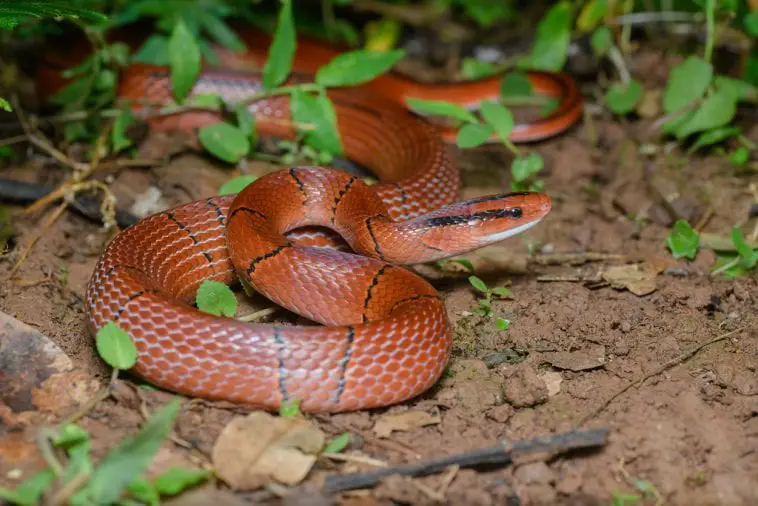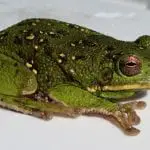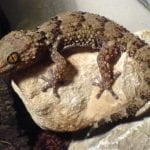Scientific Facts
| Common Name | Bamboo Rat Snake |
| Scientific Name | Oreocryptophis porphyraceus |
| Lifespan | 10 to 15 years in captivity |
| Size | 19 to 39 inches |
| Habitat | Rainforests |
| Country of Origin | Southeast Asia |
Overview
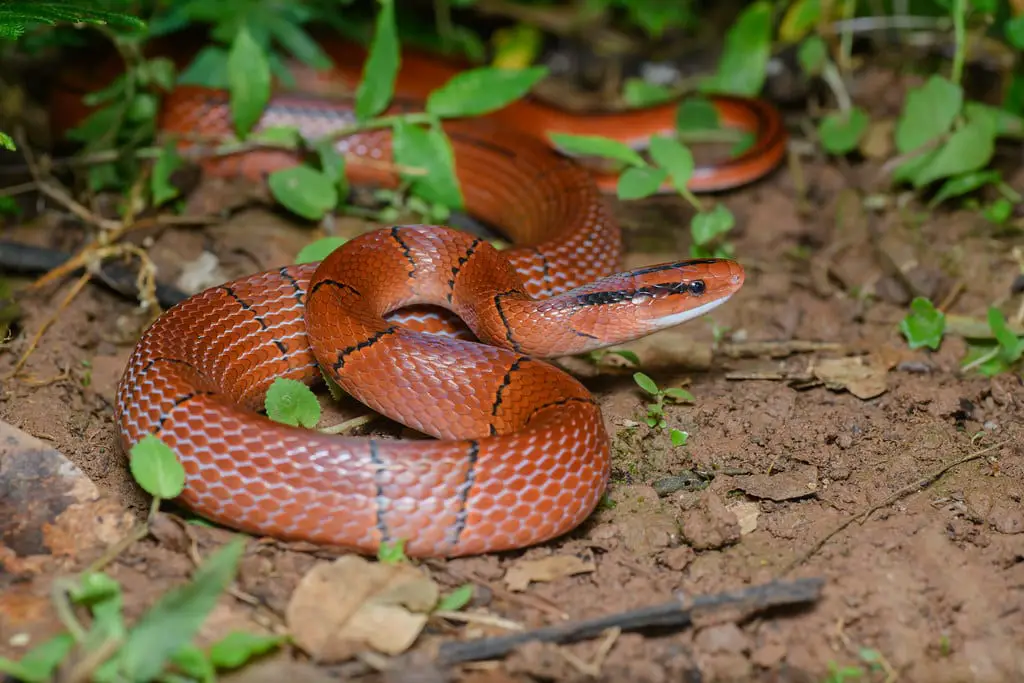
Are you a fan of the awesome display of snakes having an active and bright red color? How about having a snake that lays 3 or more clutches each year? Bamboo rat snakes are the perfect snakes to raise.
The Oreocryptophis porphyraceus is also known as the bamboo rat snake. It is relatively small and reclusive. It shows great color, and the subspecies have an interesting striping or banding. There are six recognized subspecies, but only four are bred and kept in captivity. These snakes come in orange or red as a background and stripes, which could be white, black, or yellow. Bamboo rat snakes are the most colorful. In addition, these are easy to maintain having ideal size. They are very rewarding pets. These snakes are so rare. They don’t live around the human settlement. In Thailand, they are strictly protected by the government and concerned organizations.
Physical Description
This species reaches 50 to 100 centimeters. They come with their patterns and striking colors. They are very similar to Sinomicrucus, a venomous snake. They have a smooth scale and a slender body. Their head is not much away from their neck and body. It is an oval-shaped. Since they are nocturnal, their eyes are fully and well developed.
The belly is cream to white without obvious patterns. The overall color of the body is bright to deep dark red. Adult’s pattern has black bands, black lines, or thin lines as their pattern along their whole body’s length. The hatchlings are totally different from the adults because their color is brighter and patterns are more distinct.
Size
These snakes can grow up to 120 centimeters, but they usually reach a length of 80-90 centimeters.
Lifespan
They can live for 10 to 15 years in captivity when given the right husbandry.
Subspecies
The subspecies are O. p. pulchra, O., p. vaillanti, O., p. laticincta and O. p. coxi. They are all small. These species are fossorial and secretive. They spend their time mostly under grasses and mosses, as well as rocks and logs where it is cool and moist. They also avoid the sun and chooses the cool temperature in the early morning or late afternoon. They are mostly active during this time.
A. Oreocryptophis porphyraceus coxi.
This is the Thai red mountain rat snake. This has been under captivity for the longest time. They are naturally distributed in Northeastern of Thailand especially in Phuluang and Loei Provinces having elevation s of 2,600 and 3, 000 feet. They live on the most secondary in the rain forests. Bamboos and tall grasses are the primary plants.
B. Oreocryptophis porphyraceus vaillanti,
This is the Chinese Bamboo rat snake. This is the second to be in captivity. It comes from Vietnam, Laos, and southeast China. These snakes live in semi-evergreen and moist forests. Snakes from China are not so boldly patterned. Vaillanti has soft orange to peach having bands and brown stripes. When they age, their bands get lighter and just leave the bands’ outer edge. Vietnamese vaillanti are rare for the hobbyist.
C. Oreocryptophis porphyraceus laticincta
This is the broad-banded mountain rat snake. It was under captivity just a few years ago. They are found in Malaysia and Sumatra. They are in the rain forest with an elevation of 3,200 feet. Adults of this subspecies are the reddest. Their hatchlings are orange and yellow-banded ones separated by white and thin black rings.
D. Oreocryptophis porphyraceus pulchra
This is known more commonly as the Yunnan mountain rat snake. This is the last one to be established. They grow so slowly. Naturally, they are found in China, particularly in Sichuan and Yunan. These snakes have a preference for cooler habitats. Hatchlings are similar to adults having dark orange and faded black bands framed on both sides with small yellow rings.
Behavior
They are nocturnal and like hiding between leaves or branches on the floors of the forest. There, they hunt small prey actively. Once threatened, they crawl and hideaway. If not, they raise half of their body and make an S position and twitch their tail against the ground and other surrounding objects to make a distracting noise. They will try to bite when provoked. They don’t want to be picked up when in captivity.
Natural Range and Habitat
The six species are so fragmented in Asia. All prefer humid and wet with cool temperatures in bamboo forests and forests having thick layers of branches, leaves, or mosses. They love mountainous regions having a lot of caves and rocks.
A. Oreocryptophis porphyraceus porphyraceus.
They are found in Vietnam, Thailand, Laos, Nepal, Butan, China, and India.
B. Oreocryptophis porphyraceus coxi.
They are in the North/western Thailand region between Loie and Phatchabun provinces.
C. Oreocryptophis porphyraceus kawakamii.
They are found in Taiwan.
D. Oreocryptophis porphyraceus laticincta.
They are in the Island of Sumatra and some parts of the Malayan peninsula.
E. Oreocryptophis porphyraceus vaillanti.
They are in Hong Kong, Vietnam, and China.
F. Oreocryptophis porphyraceus pulchra.
They are found in China.
Diet
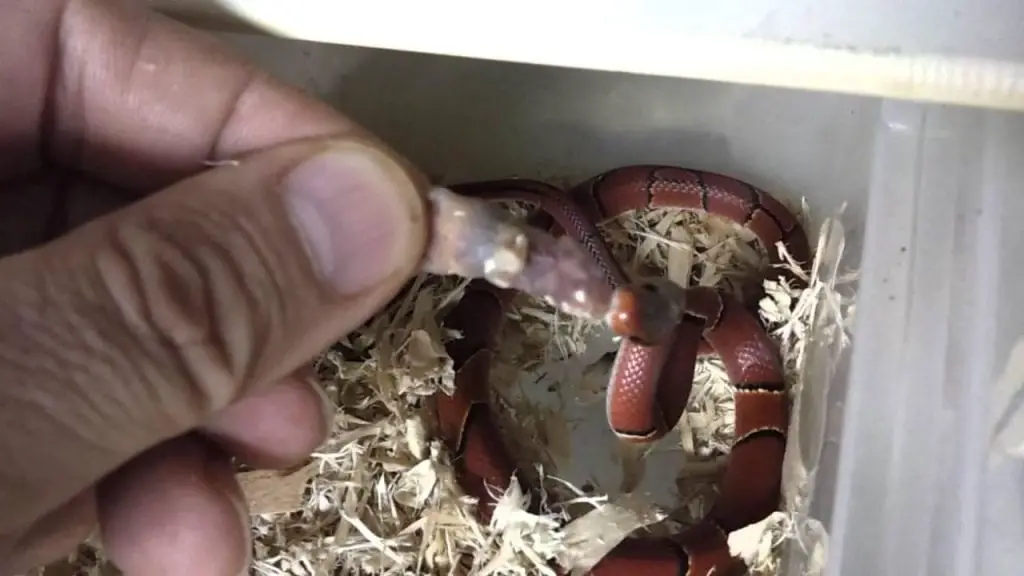
They eat all sorts of small amphibians and reptiles in the wild. Young ones are fed on small lizards and skinks. When they are in captivity, most of them eat a frozen and thawed mouse. They have a fast metabolism. Don’t give them big prey. Small to medium size prey is okay but not thicker than the snake’s thickest body part. The hatchlings and semi adults are fed every 4 to 6 days, while adults eat every 7 days.
Give the females 2 to 3 pieces of prey every feeding time, but that depends on their size. Males are fine with 1 food item per week. Increased feeding will not lead to an increase in eggs.
Hibernation
In order to have a simulation of a natural season and breeding, set the temperature at 10 degrees Celsius going to six degrees Celsius in winter. This time the females get rest from egg production.
Some hatchlings will not eat until the hibernation is done. To undergo hibernation, don’t feed them for 14 days in normal condition. Put them in a box having moss layers and cork for hiding. Put a bowl of water. Then, drop the temperature for a month, having 15 to 22 degrees Celsius. Then, place them in the hibernation chamber. The chamber can be adjusted ref or your cool basement. Keep them that way for 12 to 16 weeks.
Captive Requirements
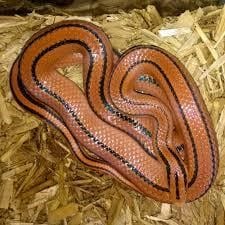
These snakes are so easy to keep. The only thing is temperature as they don’t have tolerance for high temperature in the long term because they come from cool and humid environments. Keep these snakes at 20 to 25 degrees Celsius. Some species have tolerance, but the long term leads to stress, not feeding or death. These snakes don’t climb and have a secretive way of lifestyle. It is good to keep them in a snake rack. The set-up is using cypress as a substrate and a hide box having moist moss. Change the substrate every month and clean the feces every day. This setup is good when introducing new snakes to your collection, making feeding, and noticing easy.
In addition, they are great keeping in a natural decorated set up having plants and lots of logs and cork for hiding and crawling. Substrates would be cypress, mosses, leaves, and cocopeat. Include drainage when using a complete bioactive type of set up. Ficus , Asplenium, Scindapsus, and Epipremnum are some plants that can be used. They do well for your snakes’ preferences, especially in keeping humidity. Include logs, bamboo, branches, and cork bark as decorations. These snakes make holes and systems of tunnels and get active for food hunting in the evening and night and hide mostly in the daytime. The light could also be a factor for their hiding. They avoid bright lights, so then mist the enclosure to increase humidity. It should be 70 to 80% in the daytime and 90% at night. Put water bowls for them to soak. Replace it every day. You can keep them in pairs or separately. A 60x45x45 terrarium for an individual is okay and a 90x45x45 terrarium for a pair.
The hatchlings can be put in an enclosure of 18’ long by 7 ½’ width and 3 1/2 ‘tall for nine months to one-year-old. Then moved to a bigger one with measurements of 20’ by 15’ by 5 ½ ‘, while the large female is in a tub of 34’ by 17 1/2 ‘by 5 ½’. The temperature should be middle to high 70 degrees F. Going above that would cause distress, and over 80 F might cause their death. The newly hatch should be kept on paper towels slightly damped until the second shedding. Then, keep them again on a thick layer of cypress having one or two inches deep for burrowing. Give the right level of humidity for their health.
Breeding and Captive Propagation
Bamboo rat snakes get sexually mature after 24 months. Males reach it earlier than females, but it is advisable to wait for 30 to 36 months before breeding them. Breeding them too young would lead to health problems for the females, especially. Problems would be egg bounding or ovary issues and leading the female to death.
When they are ready, introduce the males to females when the hibernation ends, and all are back in normal condition. The males will court the females by twitching and gliding along with the females’ bodies. The males lift females’ tail to insert their hemipenis into the females’ cloaca. When the females are ready, they lift their tail, letting the males enter. Mating takes 30 minutes to a few hours.
Bamboo snake rats copulate differently. The males don’t bite the females. They stay apart; only their cloacas are touching.
Eggs and Incubation
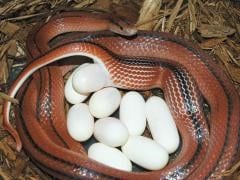
Eggs are developed in 50 to 60 days, but the females can have more clutches in a season. The clutch consists of two to eight eggs or more.
Females make their nest in moist mulch then they coil around their eggs as they are being laid. Mothers coil loosely around their eggs in the morning to guard them. Incubate the eggs in sphagnum moss or vermiculite having 25 to 29 degrees Celsius. Eggs are hatched 55 days after.
Raising Hatchling
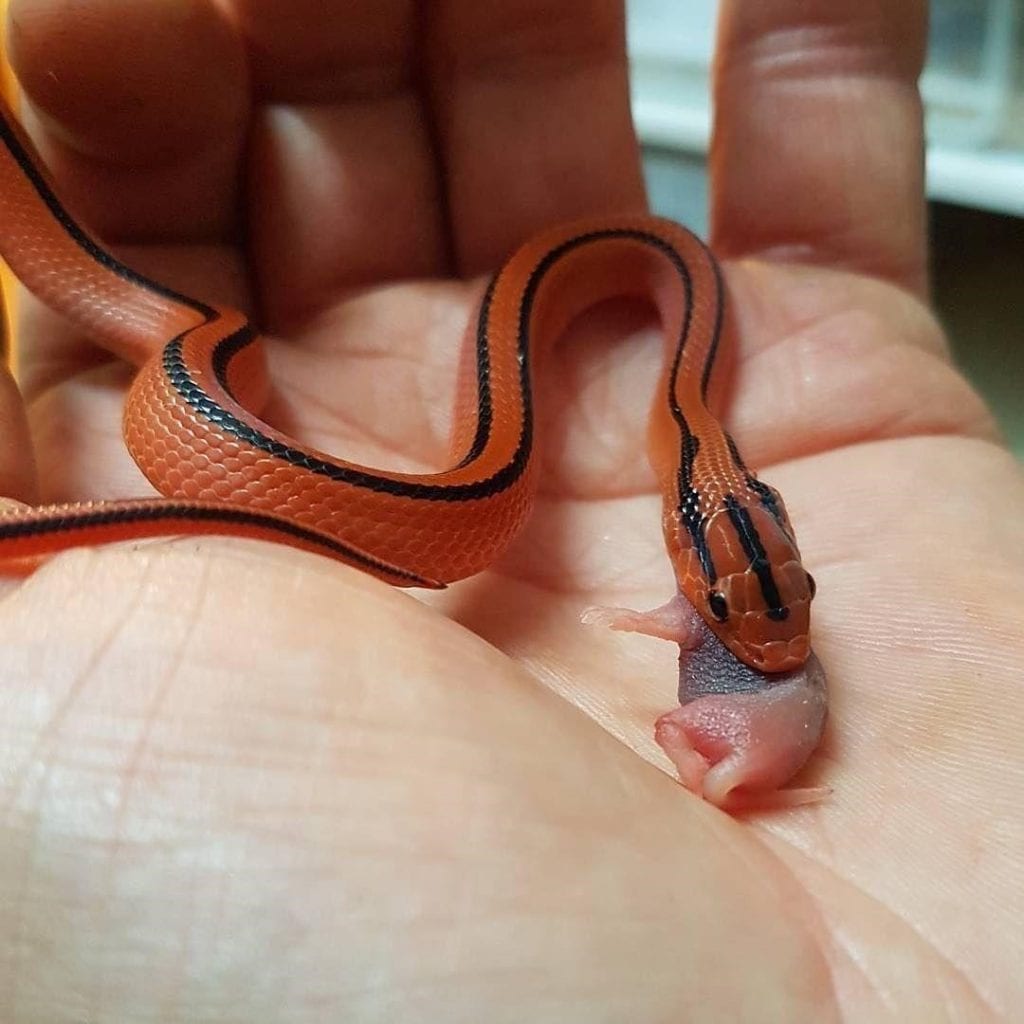
In a plastic container having moss as a substrate, set up your hatchlings there. Include a small hide for security and a rough spot for rubbing and start shedding. Don’t forget a bowl of water with clean water. Start feeding them with a dead pinky for the first shedding.
As the snakes grow bigger, give larger pinkies. Hatchlings grow fast. When they turn 4-6 months, give them 2 mice every weekly feeding. In 4 months, their size doubles, and at 1-year-old, they would have reached about 75 % of their length in adulthood.
Handling
These snakes don’t like being cuddled. Wear gloves when you handle them. Yes, they are calm and more relaxed at some moments, but they have racer moments. Give them a thin and firm grip that is enough to protect you. Some bite so fast. This is a learned behavior for them. If they sense you will put them down after they bite, they will continue biting. Take your gloves off to stop this problem before it gets worse.
Porphs don’t want to cuddle with you. While they do have their calm and relaxed moments, they also have their “racer” moments, and we highly recommend wearing gloves when handling these snakes. The key to handling highly excitable snakes is confidence, and gloves provide a great deal of confidence. We use nitrile-coated knit gloves available at Home Depot. They are thin but provide a firm grip and enough protection that you don’t have to worry about being bitten. Let your snake move from your hand to the other. Give a slight restrain from leaving your hand. Don’t force your snake. Let it feel free from your gripping while passing as you handle it.
Venom
Bamboo rat snakes are not venomous. They are definitely harmless despite having similarities with the most venomous snakes. They are beneficial, in fact, in terms of pest control in the urban, particularly the farmlands. To know which snake is venomous or not, check the pupils. Venomous has an elongated pupil usually while the rat snakes have round pupils.
Fangs
Bamboo rat snakes have tiny fangs to restrain smaller prey like rodents and rats. Their fangs are not as powerful or large like that of a venomous snake, but they can inflict pain too when they bite. They only white when handled incorrectly or not acclimated to it. In case your bitten, wash and disinfect your wound. They don’t carry parasites that could be passed to you.
Availability: Where to Get One?
Get your bamboo rat snake from reliable breeders who post online. Check their sites online or visit pet stores near you.
How to Care
Give them a secure terrarium
They are resourceful and might try to escape from their enclosure. the neonates tend to break out of the holes because they are so tiny. Therefore, ensure a tight and secure lid. Wire lids are not recommended because they are easy to break and cause injury.
Ventilation
They need fresh air but not too much, or it can hamper the maintenance of temperature. Glass cages having screen lids are ideal. It makes the cage airy, and your pets are safely tucked.
Safe Electronic components
Don’t use thermostats or hygrometer because they malfunction and cause temperature rise. If you use electronic components like OT heating or UT heating. Monitor them every day to avoid malfunctioning.
Clean and hygienic terrarium
Clean the cage to remove feces or urine. Remove the shed skin and clean the water bowl regularly. Once a month, do general cleaning. Empty the terrarium. Disinfect it. You can use a toothbrush. Also, change the substrate. Recheck your electrical components.
Common Diseases
1. Mouth Rot
This is an infection caused by bacteria brought out by injuries during feeding. It can be seen and treated easily. Check for dots on the gums. Some cases include mucus in a thick layer on the lips or too much swelling in the mouth. When your snake is infected, it will not eat.
2. Parasites
The snakes that are captive-hatched don’t have mites or parasites except for the wild-caught. Find for white dots or tiny red on their scales. If they move, these are mites. You can buy miticides, but it is safer to consult your vet. Check your snake regularly to spot any infection or mites.
3. Blister Disease
This is due to excess moisture in their enclosure. they are tiny and full of pus blister found on your snake’s underside. If it is undetected, it can be turned into an infection, and worst is ulcers and abscesses.
4. Shedding
Some snakes find it hard to shed their skin. If not spotted early, the dead skin stops the supply of blood going to the tail, and it would be amputated. Get some warm water and let your snake soak in it for 5 to 10 minutes. This will make the dead skin loose, and your snake can pull it off. If it doesn’t work, ask your vet.
FAQs
How big do bamboo rat snakes get?
They can grow as big as 40 inches, but generally, they are from 19 to 39 inches. The longest female recorded is over 40 inches.
How fast do rat snakes grow?
Your hatchling can grow up to 12 inches when given proper breeding. Then, it will take four years to be a five-foot adult.
How can you tell a rat snake?
Check the scales. Rat snakes have keeled, and weak scales have ridges. Next, measure the snake. The adults are 3 to 5 feet high.Look at their eyes. A rat snake has got round pupils.
Can a rat snake hurt you?
Yes, they can if you mishandle them. Their bite can be painful, though.
Is rat snake dangerous?
Rat snakes are non-venomous. They bite their prey with their tongue and suffocate them by constricting. They are not harmful to humans. They control rodents’ population instead.
Are rat snakes aggressive?
Bamboo rat snakes don’t want to be picked or handled. Give them time and let them feel free on your hand. Don’t force them. Always use gloves when handling.
How do you take care of a rat snake?
They like cool temperatures. Use heat lights to maintain the temperature.
Can a rat snake kill a human?
No, it can’t. They are non-venomous. Although not venomous, they can still give a painful bite.
What do rat snakes do?
Adult snakes eat birds, mice, squirrels, rats, birds, and even birds’ eggs. Juveniles eat small rodents, lizards, and the like. They are constrictors.
How often do rat snakes eat?
They eat every 5 days to a week. They eat anything when living in the wild, but when in captivity, rodents should be exclusive.
Are rat snakes poisonous to dogs?
They are non-venomous, but it could lead to some health problems with dogs. Generally, they are harmless.
How do rat snakes kill their prey?
They kill by constricting their prey. That means coiling around the prey’s body until the prey dies of suffocation.
Will, a rat snake, kill a chicken?
Yes, any breed will kill chickens, if they are suspected as food. they will try to swallow a big one.
Are rat snakes good?
They are so calm and not aggressive. They are easy to raise and don’t need much maintenance.
Can rat snakes climb walls?
Yes, some species can climb well on the walls like lizards or other insects do, but not all.
Do snakes have memory?
Yes, they do, but there is no processing through the emotional brain.
Can snakes mate with other snake species?
In the wild, snakes’ species don’t do interbreeding.

